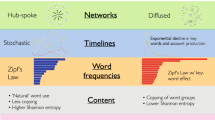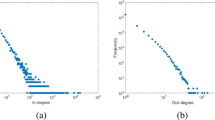Abstract
Many extreme right groups have had an online presence for some time through the use of dedicated websites. This has been accompanied by increased activity in social media platforms in recent years, enabling the dissemination of extreme right content to a wider audience. In this paper, we present an analysis of the activity of a selection of such groups on Twitter, using network representations based on reciprocal follower and interaction relationships, while also analyzing topics found in their corresponding tweets. International relationships between certain extreme right groups across geopolitical boundaries are initially identified. Furthermore, we also discover stable communities of accounts within local interaction networks, in addition to associated topics, where the underlying extreme right ideology of these communities is often identifiable.
Access this chapter
Tax calculation will be finalised at checkout
Purchases are for personal use only
Preview
Unable to display preview. Download preview PDF.
Similar content being viewed by others
References
Hoffman, D.S.: The Web of Hate: Extremists Exploit the Internet. Anti-Defamation League (1996)
Burris, V., Smith, E., Strahm, A.: White Supremacist Networks on the Internet. Sociological Focus 33(2), 215–235 (2000)
Bartlett, J., Birdwell, J., Littler, M.: The New Face of Digital Populism. Demos (2011)
Baldauf, J., Groß, A., Rafael, S., Wolf, J.: Zwischen Propaganda und Mimikry. Neonazi-Strategien in Sozialen Netzwerken. Amadeu Antonio Stiftung (2011)
Chau, M., Xu, J.: Mining communities and their relationships in blogs: A study of online hate groups. Int. J. Hum.-Comput. Stud. 65(1), 57–70 (2007)
Tateo, L.: The Italian Extreme Right On-line Network: An Exploratory Study Using an Integrated Social Network Analysis and Content Analysis Approach. Journal of Computer-Mediated Communication 10(2) (2005)
Caiani, M., Wagemann, C.: Online Networks of the Italian and German Extreme Right. Information, Communication & Society 12(1), 66–109 (2009)
Zuev, D.: The movement against illegal immigration: analysis of the central node in the Russian extreme-right movement. Nations and Nationalism 16(2), 261–284 (2010)
Blee, K.M., Creasap, K.A.: Conservative and Right-Wing Movements. Annual Review of Sociology 36, 269–286 (2010)
Bermingham, A., Conway, M., McInerney, L., O’Hare, N., Smeaton, A.F.: Combining Social Network Analysis and Sentiment Analysis to Explore the Potential for Online Radicalisation. In: Proc. International Conference on Advances in Social Network Analysis and Mining, pp. 231–236. IEEE Computer Society (2009)
Sureka, A., Kumaraguru, P.: Mining YouTube to Discover Extremist Videos. Information Retrieval, 13–24 (2010)
Goodwin, M., Ramalingam, V.: The New Radical Right: Violent and Non-Violent Movements in Europe. Institute for Strategic Dialogue (2012)
Macskassy, S.: On the Study of Social Interactions in Twitter. In: Sixth International AAAI Conference on Weblogs and Social Media, ICWSM (2012)
Takhteyev, Y., Gruzd, A., Wellman, B.: Geography of Twitter networks. Social Networks 34(1), 73–81 (2012)
Kulshrestha, J., Kooti, F., Nikravesh, A., Gummadi, K.: Geographic Dissection of the Twitter Network. In: Proc. 6th International AAAI Conference on Weblogs and Social Media (2012)
Kwak, H., Lee, C., Park, H., Moon, S.: What is Twitter, a social network or a news media? In: Proceedings of the 19th International Conference on World Wide Web, WWW 2010, pp. 591–600. ACM, New York (2010)
Lancichinetti, A., Fortunato, S.: Consensus clustering in complex networks. Sci. Rep. 2 (March 2012)
Greene, D., O’Callaghan, D., Cunningham, P.: Identifying Topical Twitter Communities via User List Aggregation. In: Proc. 2nd International Workshop on Mining Communities and People Recommenders, COMMPER 2012 (2012)
Lancichinetti, A., Radicchi, F., Ramasco, J., Fortunato, S., Ben-Jacob, E.: Finding statistically significant communities in networks. PLoS ONE 6(4), e18961 (2011)
Hubert, L., Arabie, P.: Comparing partitions. Journal of Classification, 193–218 (1985)
Hannon, J., Bennett, M., Smyth, B.: Recommending Twitter users to follow using content and collaborative filtering approaches. In: Proc. 4th ACM Conference on Recommender Systems, RecSys 2010, pp. 199–206 (2010)
Steyvers, M., Griffiths, T.: Probabilistic Topic Models. In: Landauer, T., Mcnamara, D., Dennis, S., Kintsch, W. (eds.) Latent Semantic Analysis: A Road to Meaning, Laurence Erlbaum (2006)
Deerwester, S.C., Dumais, S.T., Landauer, T.K., Furnas, G.W., Harshman, R.A.: Indexing by latent semantic analysis. Journal of the American Society of Information Science 41(6), 391–407 (1990)
Blei, D.M., Ng, A.Y., Jordan, M.I.: Latent dirichlet allocation. J. Mach. Learn. Res. 3, 993–1022 (2003)
Lee, D.D., Seung, H.S.: Learning the parts of objects by non-negative matrix factorization. Nature 401, 788–791 (1999)
Ramage, D., Dumais, S., Liebling, D.: Characterizing microblogs with topic models. In: Proc. 4th International AAAI Conference on Weblogs and Social Media (2010)
Weng, J., Lim, E.P., Jiang, J., He, Q.: TwitterRank: finding topic-sensitive influential twitterers. In: Proc. 3rd ACM International Conference on Web Search and Data Mining, pp. 261–270. ACM (2010)
Saha, A., Sindhwani, V.: Learning Evolving and Emerging Topics in Social Media: A Dynamic NMF approach with Temporal Regularization. In: Proc. 5th ACM International Conference on Web Search and Data Mining, pp. 693–702. ACM (2012)
Chemudugunta, C., Smyth, P., Steyvers, M.: Modeling General and Specific Aspects of Documents with a Probabilistic Topic Model. In: Advances in Neural Information Processing Systems, pp. 241–248 (2006)
Boutsidis, C., Gallopoulos, E.: SVD based initialization: A head start for nonnegative matrix factorization. Pattern Recogn. 41(4), 1350–1362 (2008)
Goodwin, M.: The Roots of Extremism: The English Defence League and the Counter-Jihad Challenge. Chatham House (2013)
Bartlett, J., Littler, M.: Inside the EDL: Populist Politics in a Digital Age. Demos (2011)
Netz Gegen Nazis: Nach den Portal-Sperren im Internet: Hier geht der Hass weiter. netz-gegen-nazis.de (2012)
Radke, J.: Das Ende der Nazi-Masken-Show. Die Zeit (June 2012)
Fuchs, C., Müller, D.: NSU-Prozess: Die weißen Brüder. Die Zeit (April 2013)
Störungsmelder: Nach Razzia bei Neonazi-Gruppierung “Besseres Hannover” folgt ein Verbot. Die Zeit (September 2012)
Connolly, K.: Twitter blocks neo-Nazi account in Germany. The Guardian (October 2012)
Tufekci, Z.: Big Data: Pitfalls, Methods and Concepts for an Emergent Field. SSRN (March 2013)
Boyd, D., Crawford, K.: Critical questions for big data. Information, Communication & Society 15(5), 662–679 (2012)
Author information
Authors and Affiliations
Editor information
Editors and Affiliations
Rights and permissions
Copyright information
© 2013 Springer-Verlag Berlin Heidelberg
About this paper
Cite this paper
O’Callaghan, D., Greene, D., Conway, M., Carthy, J., Cunningham, P. (2013). An Analysis of Interactions within and between Extreme Right Communities in Social Media. In: Atzmueller, M., Chin, A., Helic, D., Hotho, A. (eds) Ubiquitous Social Media Analysis. MUSE MSM 2012 2012. Lecture Notes in Computer Science(), vol 8329. Springer, Berlin, Heidelberg. https://doi.org/10.1007/978-3-642-45392-2_5
Download citation
DOI: https://doi.org/10.1007/978-3-642-45392-2_5
Publisher Name: Springer, Berlin, Heidelberg
Print ISBN: 978-3-642-45391-5
Online ISBN: 978-3-642-45392-2
eBook Packages: Computer ScienceComputer Science (R0)




